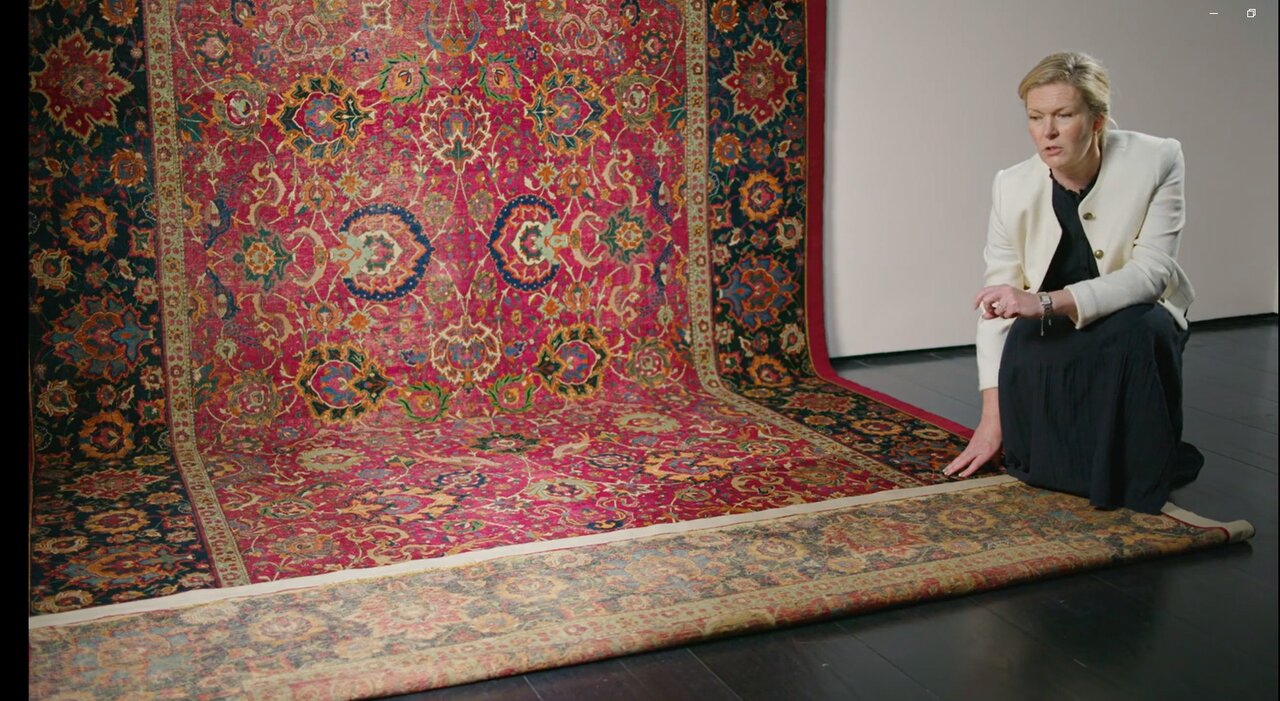400-year-old Iranian carpet up for sale at Christie’s in London

TEHRAN – A majestic Persian carpet, handwoven some 400 years ago during the Safavid era, is up for sale at Christie’s in London with a pre-sale estimate of £2-3 million.
The carpet was produced during the “Golden Age” of carpet weaving under the Safavid dynasty (1501-1732). It will be offered in Art of the Islamic and Indian Worlds including Rugs and Carpets in London on October 26.
Shah Abbas the Great, the fifth shah of Safavid monarch of Iran from 1588 to 1629, was very interested in Islamic arts, for this reason, he established weaving workshops to produce carpets for his courts and palaces and sometimes sent them to the West as ambassadorial gifts.
Louise Broadhurst, Christie’s head of Rugs & Carpets, has said that the design of this carpet is known as “pots” because of the pots on both sides of the carpet in green, orange, sugar, and pink colors.
She says the quality of the fibers, the color, and the care of this rug were so good that it looks like it was woven yesterday.
In a recent video on YouTube on Oct. 16, Broadhurst said the truly great carpet has charisma, a wonderful essence that is recreated through technical ability, an understanding of design, and an aesthetic created through high-quality materials.
Persian carpets are sought after internationally as weavers spend several months in front of a loom, stringing and knotting thousands of threads.“The carpet that we see here today was woven during the Safavid Empire, which was started at the beginning of the 16th century and continued all the way through until 1722.”
She noted court carpets were not purely woven for the floor. “These were majestic works of art created to show the wealth of the patron.”
“They were woven with finest materials, the greatest dyes, and the accomplished weavers. They were woven also as ambassadorial gifts, so they would have been gifted to visiting dignitaries, to show the wealth of the court and the ability of the artists that worked for the show.”
According to Broadhurst, the rug has been part of a British family’s collection for about a hundred years. “Having traveled from Iran in the 16th century under the rules of the Shahs, this carpet made its way through to Europe into the collection of [Baron] Edmund de Rothschild at the end of the 19th century, the expert explained.”
Elaborating on artistic details, Broadhurst said because the warps of the carpet are silk it allows the weavers to create this much finer curve. “This allows a design to be created that has a much more curvilinear form, much less geometric much less angular and this was the first time this was really being created.”
Some experts believe that this 2.5-meter carpet was once part of a 15-meter carpet, which was probably torn into pieces in the 19th century.
The art of carpet weaving has been an integral part of Iranian culture and tradition for millennia.
Persian carpets are sought after internationally as weavers spend several months in front of a loom, stringing and knotting thousands of threads.
They say each Persian carpet is a scene that seems ageless, a procedure that can take as long as a year. These efforts have long put Iran’s carpets among the most complex and labor-intensive handicrafts in the world. When the weaving is finally done, the carpet is cut, washed, and put out in the sun to dry.
Throughout history, invaders, politicians, and even enemies have left their impact on Iran’s carpets. As mentioned by the Britannica Encyclopedia, little is known about Persian carpet-making before the 15th century, when art was already approaching a peak.
For instance, the Mongol invasion of the 13th century depressed Persia’s artistic life, only partially restored by the renaissance under the Mongol Il-Khan dynasty (1256–1353). Although the conquests of Timur (who died in 1405) were in most respects disastrous to Persia, he favored artisans and spared them to work on his great palaces in Samarkand.
Later in the 17th century, there was a growing demand for the production of many gold and silver-threaded carpets that were ultimately exported to Europe. Some were made in Kashan, but many of the finest came from Isfahan. With their high-keyed fresh colors and opulence, they have affinities with European Renaissance and Baroque idioms.
At the beginning of the 18th century, nomads and town dwellers were still making carpets using dyes developed over centuries, each group maintaining an authentic tradition. Not made for an impatient Western market, these humbler rugs of the “low school” are frequently beautifully designed and are of good material and technique.
AFM
Leave a Comment